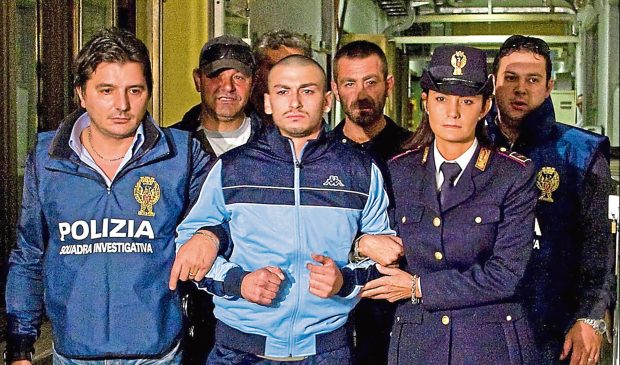
Mafia hitmen are not renowned for revealing much about their grisly exploits.
So, when Catello Romano chose to admit to three unsolved murders, it was remarkable enough.
However, the convicted killer chose to make his mea culpa not under pressure from the police, but unprompted in the pages of a university thesis.
The 33-year-old, who has spent 14 years behind bars, turned into a star university graduate by passing a sociology degree whilst in prison.
Unsurprisingly, his thesis is not the usual dry text that is only of interest to academics.
The work goes into detail about life within the mob, the moral struggles after a hit, the rewards of fancy clothes and why he has chosen to expose all this to combat crime.
The 170-page work is being pored over by Italian prosecutors because Romano has chosen to use this way to confess to unsolved crimes.
“I have committed horrendous crimes and have been convicted of several Camorra murders. What follows is my criminal history,” he writes.
From a broken home in a poor part of Naples, the heartland of the Camorra mob family, he recounts what drove him into the arms of one of the most feared mafias in the world.
In the thesis, which The Sunday Post has seen, Romano describes how he swapped his own fractured family “for another family in which I could live deeply and totally”.
“With them I constructed my alternative identity as a hard man with a mask so that I could hide the fragility of my adolescence as a way of surviving in a violent and extreme world,” Romano writes.
He describes in detail the run-up to his two first murders, conscious he has never been prosecuted for these killings.
“Through this work (thesis), I am realising a work of truth and reparation and of justice towards those who have been directly affected by my wrong actions,” Romano writes.
In 2009, Romano was convicted of the murder of Luigi Tommasino, a Naples councillor, and jailed for life.
He earned a sociology degree with the dissertation while serving his sentence in the Catanzaro prison in Calabria.
The gangster admits his first murder victims were the rising mafia leader Carmine D’Antuono and Federico Donnarumma – a man who was only murdered because he happened to be talking to D’Antuono at the time of the killing.
“Although I cannot prove it, I am sure he did nothing wrong to deserve his death,” he lamented.
Romano, who says he was admitting to the killings for the first time, says the 2008 double murder was “the most violent, traumatic and irreparable event” of his life, which left a “hole in my soul”.
Romano confesses to what he calls his “imprudence” in joining the Camorra. “I had a mad desire to be somebody, to be seen and to form part of something, stupidly bigger and more important, showing off to myself that I am worthy of this because of the cruelty and coldness to do away with a neighbour,” he writes.
He admitted that he liked the prestige, money and the trappings of a life of crime.
“I liked to dress well, and I was fond of my clothes, which had been bought with so many sacrifices,” he wrote.
“So, when I committed my first murder and I had to throw away all my clothes that I was wearing at the time in case they contained evidence, I suffered a lot and I complained for a long time, forcing my boss to promise to buy me clothes, which he never did.”
Romano said that he hoped his academic work would help understand the “criminal phenomenon” and contribute to its “possible prevention”.
“I am convinced that words are important and this autoethnographic text aims to change the world around us,” he wrote.
The academic work has created a sensation in the secretive world of the Camorra, which is famously difficult to investigate for police because of its “horizontal” cellular structure. It differs from the Sicilian Mafia and the ’Ndrangheta, whose power base is the poor southern region of Calabria.
The Cosa Nostra employs a hierarchical structure, which means to disable the “families”, law enforcement agencies must take out the leaders, made famous by the fictional Don Corleone from The Godfather.
Fluvio Bufi, a journalist for Corriere della Sera newspaper who is an expert in the Camorra, told The Sunday Post that this was not the first time a mafia killer had repented. He said that, in the 1980s, mafia boss Luigi Guilliano started naming names. He also wrote poetry and songs against crime.
“Catello is not repenting in a legal way but in a moral way with this dissertation. He has helped to catch other people in the past,” said Bufi.
“The Camorra has not said anything about this. But, as with any big crime organisation, he will be regarded as a traitor and probably be in a protection programme.”
The dissertation has been lauded by academics, who said Romano was a star pupil.
Charlie Barnao, a professor of sociology at Catanzaro University who was Romano’s thesis adviser, described him as a “brilliant student”.
“He has recounted in detail circumstances that will have consequences; he was very determined to expose that in his thesis,” Barno said.

Enjoy the convenience of having The Sunday Post delivered as a digital ePaper straight to your smartphone, tablet or computer.
Subscribe for only £5.49 a month and enjoy all the benefits of the printed paper as a digital replica.
Subscribe